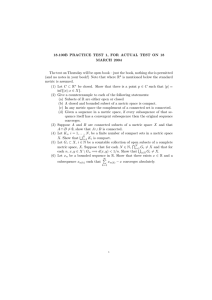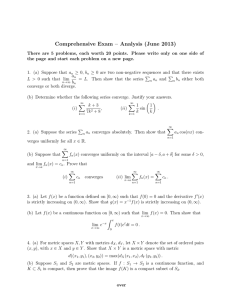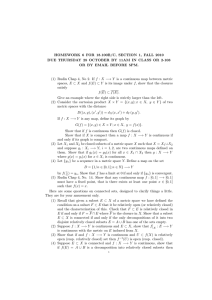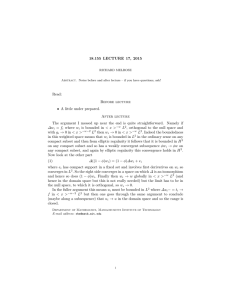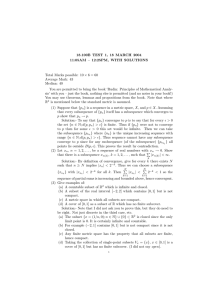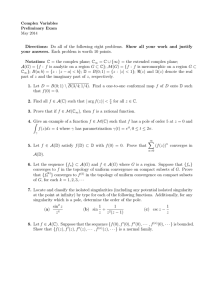HOMEWORK 6 FOR 18.100B/C, SECTION 1, FALL 2010
advertisement
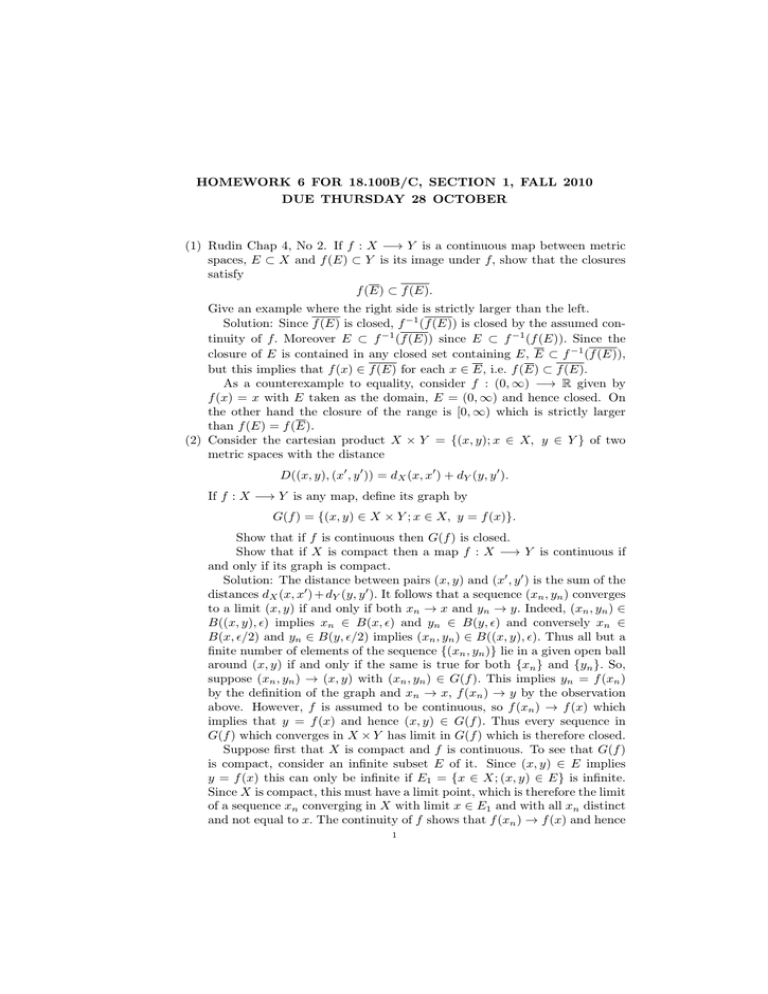
HOMEWORK 6 FOR 18.100B/C, SECTION 1, FALL 2010
DUE THURSDAY 28 OCTOBER
(1) Rudin Chap 4, No 2. If f : X −→ Y is a continuous map between metric
spaces, E ⊂ X and f (E) ⊂ Y is its image under f, show that the closures
satisfy
f (E) ⊂ f (E).
Give an example where the right side is strictly larger than the left.
Solution: Since f (E) is closed, f −1 (f (E)) is closed by the assumed continuity of f. Moreover E ⊂ f −1 (f (E)) since E ⊂ f −1 (f (E)). Since the
closure of E is contained in any closed set containing E, E ⊂ f −1 (f (E)),
but this implies that f (x) ∈ f (E) for each x ∈ E, i.e. f (E) ⊂ f (E).
As a counterexample to equality, consider f : (0, ∞) −→ R given by
f (x) = x with E taken as the domain, E = (0, ∞) and hence closed. On
the other hand the closure of the range is [0, ∞) which is strictly larger
than f (E) = f (E).
(2) Consider the cartesian product X × Y = {(x, y); x ∈ X, y ∈ Y } of two
metric spaces with the distance
D((x, y), (x0 , y 0 )) = dX (x, x0 ) + dY (y, y 0 ).
If f : X −→ Y is any map, define its graph by
G(f ) = {(x, y) ∈ X × Y ; x ∈ X, y = f (x)}.
Show that if f is continuous then G(f ) is closed.
Show that if X is compact then a map f : X −→ Y is continuous if
and only if its graph is compact.
Solution: The distance between pairs (x, y) and (x0 , y 0 ) is the sum of the
distances dX (x, x0 ) + dY (y, y 0 ). It follows that a sequence (xn , yn ) converges
to a limit (x, y) if and only if both xn → x and yn → y. Indeed, (xn , yn ) ∈
B((x, y), ) implies xn ∈ B(x, ) and yn ∈ B(y, ) and conversely xn ∈
B(x, /2) and yn ∈ B(y, /2) implies (xn , yn ) ∈ B((x, y), ). Thus all but a
finite number of elements of the sequence {(xn , yn )} lie in a given open ball
around (x, y) if and only if the same is true for both {xn } and {yn }. So,
suppose (xn , yn ) → (x, y) with (xn , yn ) ∈ G(f ). This implies yn = f (xn )
by the definition of the graph and xn → x, f (xn ) → y by the observation
above. However, f is assumed to be continuous, so f (xn ) → f (x) which
implies that y = f (x) and hence (x, y) ∈ G(f ). Thus every sequence in
G(f ) which converges in X × Y has limit in G(f ) which is therefore closed.
Suppose first that X is compact and f is continuous. To see that G(f )
is compact, consider an infinite subset E of it. Since (x, y) ∈ E implies
y = f (x) this can only be infinite if E1 = {x ∈ X; (x, y) ∈ E} is infinite.
Since X is compact, this must have a limit point, which is therefore the limit
of a sequence xn converging in X with limit x ∈ E1 and with all xn distinct
and not equal to x. The continuity of f shows that f (xn ) → f (x) and hence
1
2 HOMEWORK 6 FOR 18.100B/C, SECTION 1, FALL 2010 DUE THURSDAY 28 OCTOBER
(x, f (x)) is a limit point of E (since all the (xn , f (xn )) are distinct) so G(f )
is compact.
Conversely, suppose that G(f ) is compact (with the metric from X ×Y of
course). Consider a general C ⊂ Y which is closed. Suppose xn ∈ f −1 (C)
and xn → x in X. Then (xn , f (xn )) ∈ G(f ) has a convergent subsequence
(xnk , f (xnk ) with limit (x, y) ∈ G(f ) (since it is closed) so y = f (x) ∈ X
and since f (xnk ) → y in Y (as discussed above) y = f (x) ∈ C. Thus
x ∈ f −1 (C) which must therefore be closed and hence f must be continuous.
Here is a much more sophisticated proof of the second part based on the
fact that the two ‘projection’ maps π1 : X ×Y −→ X and π2 : X ×Y −→ Y
are both continuous. Namely for any map f the inverse image of a set
C ⊂ Y is precisely f −1 (C) = π1 (X × C ∩ G(f )). Indeed, if x ∈ f −1 (C)
then y = f (x) ∈ C so there is a point (x, f (x)) ∈ G(f ) ∩ (X × C) with
π1 ((x, f (x)) = x. Conversely if x = π1 (x, y) with (x, y) ∈ G(f ) ∩ (X × C)
then y = f (x) ∈ C. Now, X × C = π2−1 (C) so we have written f −1 (C) =
π1 (G(f ) ∩ π2−1 (C)). If C is closed and we assume that G(f ) is compact then
π2−1 (C) is closed by the continuity of π2 , G(f ) ∩ (π2−1 (C)) is compact by
the assumed compactness of G(f ) and hence f −1 (C) = π1 (G(f ) ∩ π2−1 (C))
is compact, by the continuity of π1 hence closed. Thus f is continuous
since the inverse image of any closed set is closed. The corresponding
‘sophisticated’ proof of the first part (proving G(f )) is compact) is to realize
that if f is continous then the map If : X −→ Y ×Y where If (x) = (x, f (x))
is also continuous – using for instance the convergence discussion above – so
G(f ) = If (X) is compact if X is compact. You could also see the converse,
assuming G(f ) is compact, by observing that Lf : X −→ G(f ), just If with
the target space reduced to G(f ), is 1-1 and onto and has continuous inverse
π1 G(f ) so, by a Theorem in Rudin, the inverse of π1 , i.e. Lf : X −→ G(f )
is continuous, but then f = π2 ∩ Lf is also continuous.
So many possibilities it is hard to choose . . . .
(3) Let X1 and X2 be closed subsets of a metric space X such that X = X1 ∪X2
and suppose gi : Xi −→ Y, i = 1, 2, are two continuous maps defined on
them. Show that if g1 (x) = g2 (x) for all x ∈ X1 ∩ X2 then g : X −→ Y
where g(x) = gi (x) for x ∈ Xi is continuous.
Solution: First note that g : X −→ Y is a well-defined map, since if
x ∈ X then either x ∈ X1 \ X2 or x ∈ X2 \ X2 or x ∈ X1 ∩ X2 . In each case
g(x) is well defined as g1 (x), g2 (x) or the common value g1 (x) = g2 (x).
Maybe the conceptually easiest way to see the continuity is to use sequences. Suppose xn → x in X. Consider all those xn which lie in X1 . If
there are only finitely many then eventually xn ∈ X2 and hence g(xn ) =
g2 (xn ) for large n converges to g2 (x) = g(x) since X2 is closed (so x ∈ X2 )
and g2 is continuous. Otherwise there is a subsequence of xn in X1 which
therefore converges to x ∈ X1 , since X1 is closed, so along this subsequence
g1 (xnk ) → g1 (x) = g(x). Now, either the number of points not in X1 is finite or else forms a subsequence in X2 , which therefore converges as before.
In the first case it follows immediately g(xn ) → g(x) and also in the second,
since give an open ball centered at g(x) the image of the first subsequence
under g1 and the image of the complementary subsequence under g2 both
HOMEWORK 6 FOR 18.100B/C, SECTION 1, FALL 2010
DUE THURSDAY 28 OCTOBER 3
line in this ball from some integer onwards. Thus g(xn ) → g(x) in all cases
and hence g is continuous.
It is probably easier to use closed sets. Suppose C ⊂ Y is closed. Then
x ∈ g −1 (C) if either x ∈ X1 and g1 (x) ∈ C or x ∈ X2 and g2 (x) ∈ C.
Thus g −1 (C) = g1−1 (C) ∪ g2−1 (C). By assumption g1 : X1 −→ Y and
g2 : X2 −→ Y are continuous, so gi−1 (C) ⊂ Xi for i = 1, 2, is closed as
a subset of Xi as a metric space. However, since the Xi are closed, being
relatively closed in Xi is the same as being closed in X. Thus g −1 (C) is
closed, as the union of two closed sets.
(4) Let {yn } be a sequence in a metric space Y. Define a map on the set
D = {1/n ∈ [0, 1]; n ∈ N} −→ Y
f ( n1 )
= yn . Show that f has a limit at 0 if and only if {yn } is convergent.
Solution. This is just the definitions. Namely, f has a limit y at 0 if and
only if, given > 0 there exists δ > 0 such that 0 < d(0, 1/n) = 1/n < δ
implies d(y, f (1/n)) = d(y, yn ) < . Of course yn → y if and only if given
> 0 there exists N such that n > N implies d(y, yn ) < . These are
completely equivalent, just by taking N = 1/δ.
(5) Rudin Chap 4, No. 14. Show that any continuous map f : [0, 1] −→ [0, 1]
must have a fixed point, that is there exists at least one point x ∈ [0, 1]
such that f (x) = x.
Solution: Consider the subsets L = {x ∈ [0, 1]; f (x) ≤ x} and U = {x ∈
[0, 1]; f (x) ≥ x}. These are non-empty, since 0 ∈ L and 1 ∈ U. They are
both closed, since g : [0, 1] −→ R defined by g(x) = f (x) − x is continuous
and L = g −1 ((∞, 0]), U = g −1 ([0, ∞)). A point x ∈ [0, 1] satisfies f (x) = x
if and only if x ∈ L ∩ U. The set L ∩ U cannot be empty, since if it was then
L and U would be non-empty, disjoint, closed subsets with L ∪ U = [0, 1]
contradicting the known connectedness of [0, 1]. Thus at least one such fixed
point must exist.
Here are some questions on connected sets, designed to clarify things a little.
They are for your amusement only.
(1) Recall that given a subset E ⊂ X of a metric space we have defined the
condition on a subset F ⊂ E that it be relatively open (or relatively closed)
and the characterization of this. Check that F ⊂ E is relatively closed in
E if and only if F = F ∩ E where F is the closure in X. Show that a subset
E ⊂ X is connected if and only if the only decompositions of it into two
disjoint relatively closed subsets E = A ∪ B has one of the sets
empty.
(2) Suppose f : X −→ Y is continuous and E ⊂ X, show that f E : E −→ Y
is continuous with the metric on E induced from X.
(3) Show that if and f : X −→ Y is continuous and U ⊂ f (X) is relatively
open (resp. relatively closed) set then f −1 (U ) is open (resp. closed).
(4) Suppose E ⊂ X is connected and f : X −→ Y is continuous, show that
if f (E) = A ∪ B is a decomposition into relatively closed subsets then
−1
−1
E = (E ∩ f −1 (A)) ∪ (E ∩ f −1 (B)) = f E (A) ∪ f E (B) is a decomposition
into relatively closed subsets.
(5) Deduce from this that the continuous image of a connected set is connected.
by
